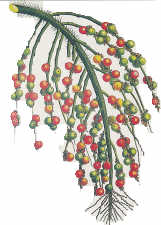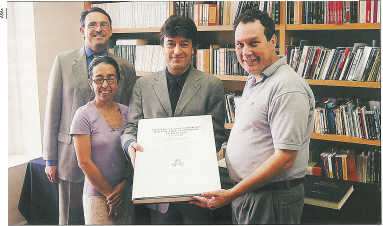Jose Celestino Mutis
Javier Francisco-Ortega, Head of the FIU/FTG Molecular Systematics and Conservation Genetics Laboratory,
Fairchild Garden Assistant Professor, Biological Sciences, Florida International University
The 17th and 18th centuries were the Golden Age of natural history explorations. During this time, the major European powers developed scientific expeditions to study the botany, zoology, and geology of their overseas colonies. Spain, which had many colonies at this time, officially sponsored seven scientific expeditions between 1754 and 1808.
Expeditions were sent to Venezuela, Peru, Colombia, the Philippines, the Pacific Ocean, Mexico, and the West Indies. One of the most notable expeditions, organized by Jose Celestino Mutis, was carried out during the late 17th and early 18th centuries. On this expedition, the botanical and zoological richness of northern South America in Colombia, known then as the Virreinato de Nueva Granada, was revealed.
Celestino Mutis was born in Andalucia in the city of Cadiz in 1732. He studied medicine in Seville and Cadiz; in 1760 he traveled to Colombia, where he lived until his death in 1808. Soon after his arrival, he developed a passion for the natural history of Colombia. He contacted the Spanish king on several occasions for support in organizing a scientific expedition to explore the natural history of the New World. It was not until 1783, after 20 years, that the first Bourbon King of Spain, Carlos III, approved the expedition.
Between 1783 and 1808, Mutis tirelessly led an extraordinary endeavor to collect and illustrate the plants of Colombia. To accomplish this huge project, he recruited and trained several illustrators and botanists, mostly from Colombia. After his death, this work was carried on by one of his most important students, Francisco Jose Caldas, who was killed in 1810 during the wars of independence between the South American colonies and the Kingdom of Spain.
In 1816, the King of Spain ordered all the descriptions, herbarium sheets, and illustrations of the Expedici6n Botanica de Nueva Granada to be shipped to Spain. They are currently deposited at the Royal 80tanic Garden of Madrid. In three decades, this expedition produced more than 6,000 illustrations and 24,000 herbarium specimens. At one time, twenty illustrators worked simultaneously on these extraordinary illustrations.
Mutis was highly regarded by his contemporary botanists; the great Linneaus considered him as the most important botanist of the New World and called him "Phytigorum Americanorum Princeps." Linneaus himself received many plants from Mutis. Among them was a strange climbing daisy with red flowers. Later Linnaeus' son dedicated this plant to Mutis under the genus name of Mutisia. Recent evolutionary studies have demonstrated that this is one of the most primitive genera of the plant family of daisies. Humboldt and Bonpland were hosted by Mutis during two months in 1801. Humboldt referred to Mutis with admiration in his two famous books Plantas Equinoctiales and Biographie Universelle.
In 1929, the collections of Mutis in Madrid were rediscovered by the American botanist Ellsworth Paine Killip, leading to a resurgence of interest in Mutis’ work. But it was not until the end of the Spanish Civil War and World War II that the governments of Spain and Colombia joined forces to publish the botanical descriptions and illustrations of the Expedici6n Botanica. The first volume of this work was published in 1953; at present 23 volumes with more than 500 illustrations and scientific descriptions have been published.
The legacy of Mutis is extraordinary. His work went beyond the organization and leadership of one of the most important European scientific expeditions made in the New World: he directed a generation of Latin American botanists and scientists, and the establishment of the first Latin American scientific institutes. Mutis represents a superb example and reference for botanists. His perseverance, work ethics and love for the country that adopted him are examples for many of us who often need to carry out our research with limited resources.
Garden Views Winter 2004

